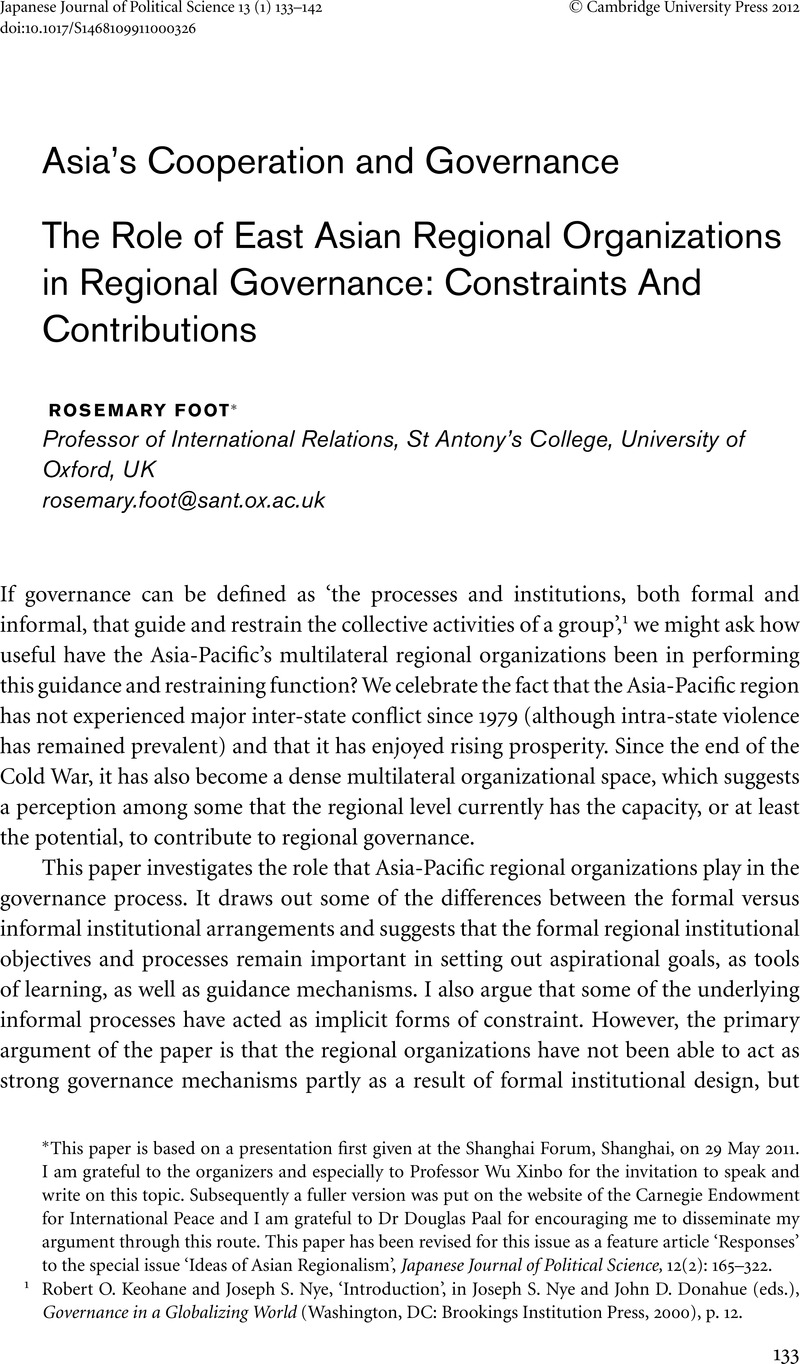Published online by Cambridge University Press: 27 January 2012

1 Keohane, Robert O. and Nye, Joseph S., ‘Introduction’, in Nye, Joseph S. and Donahue, John D. (eds.), Governance in a Globalizing World (Washington, DC: Brookings Institution Press, 2000), p. 12Google Scholar.
2 That is, the ten ASEAN countries, plus ASEAN's ten dialogue partners (Australia, Canada, China, the EU, India, Japan, New Zealand, the Republic of Korea (ROK), Russia, and the United States), together with six other members – the DPRK, Mongolia, Pakistan, Timor Leste, Bangladesh, and Sri Lanka, and an ASEAN observer (Papua New Guinea.)
3 The member economies are Australia, Brunei, Canada, Chile, the PRC, Hong Kong, Indonesia, Japan, the ROK, Malaysia, Mexico, New Zealand, Papua New Guinea, Peru, the Philippines, Russia, Singapore, Chinese Taipei, Thailand, the United States, and Vietnam.
4 The Plus Three are the ROK, China, and Japan.
5 The ASEAN ten plus Australia, China, India, Japan, New Zealand, ROK, Russia and the United States.
6 The five founding members of ASEAN are Indonesia, Malaysia, the Philippines, Singapore, and Thailand. Brunei joined in 1984, Vietnam, Laos, and Burma/Myanmar in 1995, and Cambodia in 1999.
7 This is a slight modification of a point made in Acharya, Amitav and Johnston, Alastair Iain (eds.), Crafting Cooperation (Cambridge University Press, 2007), p. 12Google Scholar.
8 ASEAN Declaration (Bangkok Declaration), 8 August 1967, www.aseansec.org/64.htm (accessed 22 November 2011).
9 Mission Statement, Asia-Pacific Economic Cooperation, www.apec.org/About-Us/About-APEC/Mission-Statement.aspx (accessed 22 November 2011).
10 The Kuala Lumpur Declaration on the East Asian Summit, 14 December 2005, Kuala Lumpur, available at www.aseansec.org/18098.htm (accessed 30 March 2011).
11 Haacke, Jurgen, ‘The ASEAN Regional Forum: from dialogue to practical security cooperation?’, Cambridge Review of International Affairs, 22 (3) (2009) 428−42CrossRefGoogle Scholar.
12 Shulong, Chu, ‘The ASEAN Plus Three Process and East Asian Security Cooperation’, in Acharya, Amitav and Goh, Evelyn (eds.), Reassessing Security Cooperation in the Asia-Pacific (Cambridge, MA: MIT Press, 2007)Google Scholar.
13 Acharya, Amitav, Whose Ideas Matter? (Ithaca, NY: Cornell University Press, 2009), p. 69CrossRefGoogle Scholar.
14 The DPRK is a member of the ARF, one major reason why such a debate is not likely to occur.
15 Simon, Sheldon W., ‘Whither Security Regionalism? ASEAN and the ARF in the Face of New Security Challenges’, in Acharya, Amitav and Goh, Evelyn (eds.), Reassessing Security Cooperation in the Asia-Pacific (Cambridge, MA: MIT Press, 2007) pp. 123−4Google Scholar.
16 Yuen Foong Khong and Helen Nesadurai, ‘Hanging Together, Institutional Design, and Cooperation in Southeast Asia: AFTA and the ARF’, in Acharya and Johnston (eds.) Crafting Cooperation, p. 49.
17 According to Jurgen Haacke, within the ARF, initiatives to move beyond dialogue to practical cooperation have mainly come from Australia, Canada, Japan, and the United States; Haacke, ‘The ASEAN Regional Forum’, p. 443.
18 Haacke, ‘The ASEAN Regional Forum’, p. 442, quoting from the ARF Chairman's Statement, 15th ARF, 24 July 2008.
19 Khong and Nesadurai, ‘Hanging Together’, p. 49.
20 I mention a mixed result, however, because the crisis did spur the +3 countries to expand the reserves, to announce additional swap lines, and from March 2010 to inaugurate a multilateral Chiang Mai Initiative. Amy Searight, ‘Special Assessment: Asian Regionalism: New Challenges, New Vision, Pedestrian Progress’, Comparative Connections (April 2010), p. 3.
21 The Court, much to Jakarta's chagrin, ruled in Malaysia's favour in December 2002.
22 Mainly connected with China's increased capacities, despite its reasonably successful reassurance strategy at least for the ten years after 1997.
23 For example, between China and Japan, with each reluctant to see the other take on a leadership role in the region.
24 For example, between China and the United States, Singapore and Malaysia, North and South Korea, China and Vietnam, among some others.
25 A fear that is prevalent among ASEAN members.
26 William W. Grimes, ‘The Asian Monetary Fund Reborn? Implication of Chiang Mai Initiative Multilateralization’, Asia Policy, 11 (January 2011): 79−104.
27 As Chu Shulong puts it: ‘the APT is the most truly Asian approach . . . if Asians want, need, and should have their own multilateral regional approach or mechanism, the APT is the right and only one in Asia today’. ‘The ASEAN Plus Three Process’, p. 161.
28 Yoshihide Soeya, ‘An East Asian Community and Japan-China Relations’ at www.jiia.or.jp/en_commentary/201004/30-1.html (accessed 30 April 2010). See also Takashi Terada, ‘The Origins of ASEAN+6 and Japan's Initiatives’, The Pacific Review, 23(1) (2010). Subsequently, Russia and the United States have joined the EAS.
29 Alice D. Ba, [Re]negotiating East Asia (Stanford, CA: Stanford University Press, 2009), p. 217. Unsurprisingly, therefore, ASEAN members were especially hostile to the then Australian Prime Minister, Kevin Rudd's, proposal for an Asia Pacific Community, a body that was to span the whole region, but that failed to ‘give adequate recognition to ASEAN's central role in regional architecture’. Searight, ‘Asian Regionalism’, p. 6.
30 Amy Searight, ‘Special Assessment: Asian Regionalism’, Comparative Connections, a quarterly e-journal, April 2010.